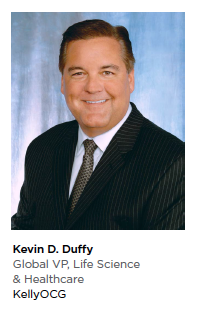 In today’s rapidly changing market, organizations and workforce experts alike are trying to determine how the future of work will transform. However, most professionals operate from the perspective of their individual scope of responsibility, which often leads to narrow perspectives that may solve one aspect of the challenge — yet create another problem.
In today’s rapidly changing market, organizations and workforce experts alike are trying to determine how the future of work will transform. However, most professionals operate from the perspective of their individual scope of responsibility, which often leads to narrow perspectives that may solve one aspect of the challenge — yet create another problem.
Based on conversations across the market and our in-depth research, KellyOCG has determined that there are four dimensions organizations need to consider when contemplating the “Future of Work": technology, the workforce, the workplace, and social norms.
By taking these dimensions into account, organizations can better gain a comprehensive overview of the range of models they may want to utilize to engage and execute within their workforce plan. Further, they can assess which combination of models will drive their desired business outcomes. Achieving a broader focus based upon all relevant information will lead to more truly informed strategies. This can enhance organizations’ workforces, and by extension, their ability to achieve their operational goals.
Technology
For life-science and healthcare companies, the “Future of Work" includes the acceleration and utilization of digital technologies and platforms, including artificial intelligence (AI). With the cost of bringing a drug to market projected at an estimated $1.5 billion, driving more adaptive clinical trials and optimizing patient data is more critical than ever. The sector is in the early stages of digital transformation and turning to the use of cloud-based tools that enhance quality, speed, efficiency, and safety which will require an entirely different set of programming skills from the workforce. Additionally, the FDA is currently in a pilot program to certify providers of digital health platforms that will clearly affect the make and mix of skills needed in future workforces within the biopharmaceutical and healthcare sector.
Further, with 90% of drug candidates failing to reach approval, it will be a necessity to adopt AI to remain competitive in this market sector. Currently, nearly half of life-science professionals are using or experimenting with AI, with the goal of improving both the quality of drug development as well as the speed at which life-saving therapies are delivered to the market.
Applications could include using modern supercomputers and machine learning systems to predict how molecules will behave; identifying physicians with relevant patients when launching new products; optimizing salesforce deployment; improving overall communication with physicians; identifying patients with rare diseases sooner; and/or predicting segments of patients that will respond well to a specific therapy.
The Workplace
Additionally, if Millennials’ work environments don’t meet their requirements or moral codes, they are quick to move on to other opportunities. In the face of this changing workforce, companies are prioritizing location and space with the ability to improve the well-being of their employees. This will lead to more amenity-rich spaces to accommodate the expectations of this next generation of the life-science workforce.
According to data from Remote Year, more than 50% of the workforce currently works remotely at least one day per week. Co-location spaces are becoming more and more popular, not just among small start-ups but also enterprise-size companies that are looking to engage top talent or to create a collaborative environment for their teams. Companies need to make these considerations when they are evaluating culture, talent needs, and communication impacts. It is no longer a world where everyone works onsite, with a set schedule, in a defined way.
The Workforce
With more than 50% of the life-science workforce at 45-plus years or older and fewer candidates within STEM disciplines, the competition for this unique talent is at an all-time premium, particularly in the United States. However, to remain competitive, leading organizations are exploring the thriving gig economy. Free agent ranks have grown over the years from a small minority to a sizeable crowd. Today, gig workers make up 31% of the global workforce. In the United States alone, there are 50 million free agents, comprising 33% of the country’s workforce.
In fact, the majority of global talent managers are leveraging gig workers, also known as free agents, in their teams and departments to drive cost savings, innovation, and competitive advantage. By utilizing the skills and expertise of as-needed freelance talent, without the restraints and bureaucracy of traditional employment, organizations are more nimble, innovative, and competitive within a lightning-fast economy.
While there are usage variances across geographies, industries, and skill sets, all signs point to the gig economy being a compelling force with which to be reckoned.
According to 62% of global talent managers who use free agents within their departments, free agents are the workers of the future. Nearly two-thirds (65%) of talent managers think the gig economy is becoming the new normal for how businesses organize work, and almost three quarters (73%) believe a much more flexible and fluid workforce will emerge as a way to navigate an increasingly dynamic, global business climate. Seven out of 10 talent managers using free agents see the employer-worker relationship shifting, with talent asserting more leverage, as well as a desire to be treated the way they are treated as consumers in their personal lives.
The vast majority of gig workers are highly skilled and educated. They value developing their careers, creative expression, and are highly committed to their work and their earning power. In fact, more than eight out of 10 free agents in the United States play a key role in their households’ financial well-being.
Additionally, free agents work and live this way by choice. Demographic and psychographic shifts and rapid technological advancement are driving a re-imagined relationship between work and the rest of life. Three-quarters of global free agents choose free agency for positive reasons, with personal empowerment and career opportunities topping the list.
Social Norms
As the world of work changes, the employer-employee relationship is shifting right along with it. Long-term commitments to employers are waning. The best talent is seeking greater control and ownership over how they integrate work with their personal lives and passions. With this shift in the way that the world wants to work, careers built on flexibility continue to gain ground.
For life-science and healthcare companies to remain competitive, they need to ensure they have a talent supply chain in place and the human capital they need to address this changing workplace. Millennials, in particular, have very specific expectations regarding work. They want to be on the cusp of innovation, and they want their employer’s corporate culture to align with their values and goals.
Conclusion
For life-science and healthcare organizations, there is significant opportunity as the way in which talent wants to be engaged continues to shift. Today’s talent lives by the adage “doing well by doing good," yet at the same time strives to maintain a flexible and balanced work/life experience. They desire “perks" such as childcare facilities, caregiver support, flexible work hours, and work-from-home policies, in addition to access to world-class academic institutions, exposure to top-notch research facilities, and inclusion within a tight-knit medical community.
In conclusion, the challenges facing companies today are complex. Effecting change on so many levels is no small task. Organizations need to know what dimensions to look at to gain a comprehensive overview and consequently break down the complexity in order to determine what’s important for their workforce strategies.
This forward-thinking employment-engagement model will result in the attraction and retention of the desired talent for the future.(PV)
KellyOCG is the leading global advisor of talent supply chain strategies, aligning talent strategy to business strategy across all internal and external worker categories. We connect talent and business together in a way that advances careers and business goals alike.
For more information, visit kellyocg.com.


















